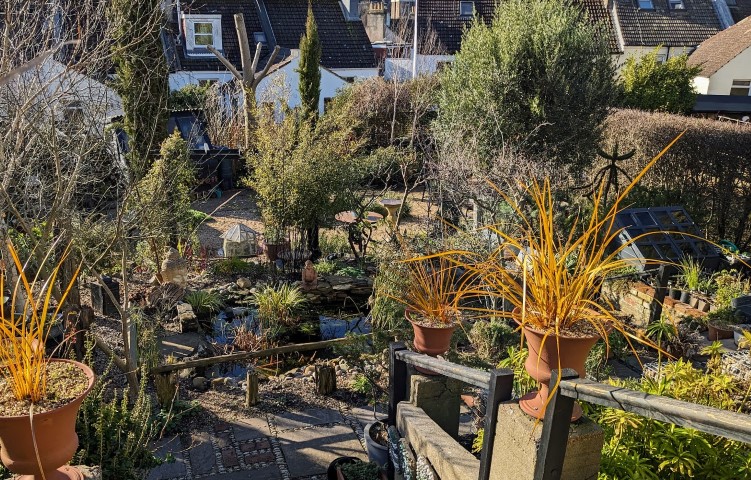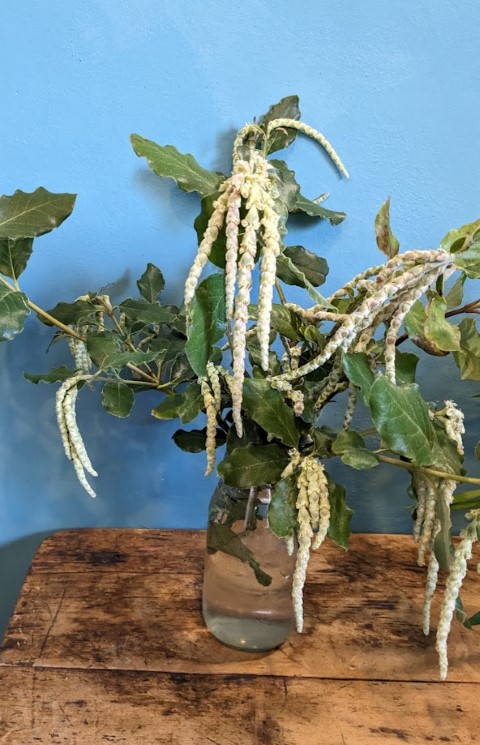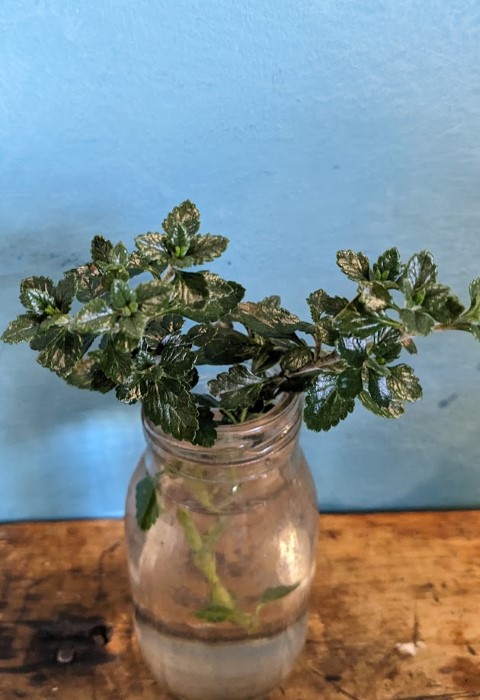Our group was slightly depleted this week due to some members having outside duties, or being on holiday (lucky things), and others falling victim to the numerous viruses and bugs going around (not so lucky). However, we gathered in the gorgeous January sun which is really giving hints of spring, even if that’s a way off.
Ident
Deborah had collected some examples of plants for winter interest and/or evergreen structure in the garden. Since starting at the Garden House, I have found that shrubs are the hardest group for me to recognise, name and commit to memory. I’m hoping this will help…
Garrya elliptica
(Garrya – named for Nicholas Garry, who was secretary of the Hudson’s Bay Company circa 1820-35 . Elliptaca – shaped like an ellipse in reference to the shape of the leaves)
The silk tassel bush is a large shrub or small tree that is dioecious – growing as separate male and female plants. They are vigorous and evergreen with wavy-edged, leathery leaves which are shiny on top and felted underneath. Long silvery-grey catkins, which shine out amongst the darker foliage, develop on the male plants in January and February. The lesser-used female plants produce clusters of long, purple-brown fruits in summer.
They are good coastal windbreak plants as they are extremely tough but offer a stunning feature in a winter garden – grown against, or possibly trained up a wall to display the catkins to their best effect. Any reasonable soil, any position and hardy throughout most of the U.K. - how often do I say that? Ht. up to 4m after 10 years.
Clematis cirrhosa var. balearica
( cirrhosa – with tendrils)
Otherwise known as the fern-leaved clematis, most of us assumed this was the cultivar ‘Freckles’ when Deborah showed it to us as there is a gorgeous example of it at GH. This, however, is slightly different with a paler, more creamy flower. These slightly fragrant flowers are speckled with reddish-maroon spots and appear from December to February, contrasting with bronze-tinged, evergreen, ferny leaves. These are followed by whiskery seedheads. This is a wonderfully attractive winter plant which does best trained over a sunny, sheltered pergola, arch or doorway with its roots in moist but well-drained soil but out of the direct sun. It is a ‘Group 1 Clematis’, meaning that it requires very little pruning, only enough to restrict its growth or to remove any damaged parts after flowering. Ht. up to 2.5m trained.
Taxus baccata
(baccata – bearing berries)
The common yew is a medium-sized bushy, dioecious evergreen tree with tiny, narrow, leathery, dark green leaves arranged in two rows on the shoots. Small red berries appear on female plants in late summer. Growth is slow to moderate but the density of foliage makes for excellent shaping and topiary requiring only one pruning per year, generally in late summer. It is increasingly used as an alternative to box.



Yews are known for their versatility, longevity, and adaptability to different growing conditions. They can tolerate a range of soil types but prefer well-drained soil. Ht. up to 12m if left unpruned. Caution – Yew leaves are highly toxic to humans and animals if ingested.
Teucrium x lucidrys
( I could not find a meaning for lucidrys)
The hybrid germander is a low- growing bushy plant with dark green crinkly edged, glossy leaves and short spires of small pink flowers in early summer. It is highly drought-tolerant and gives a fresh-green look among more grey-green “dry” plants. It needs full sun and a light, well-drained soil.
I think it is the same plant we have looked at before – Teucrium chamaedrys that is edging the herb beds at GH – just a confusion in the naming.
Now for three Pittisporums…this is a genus of about 200 evergreen trees and shrubs from Australasia and Oceana with some found in areas of Asia and Africa. They come in various sizes, from large and conical to compact and domed, with shiny, often variegated or colourful leaves and small scented flowers. You can also grow them as hedging or clipped into simple shapes. They like a sunny, sheltered location and well-drained soil. Some are hardy but many need protection in harsh winters.
Pittisporum tenuifolium ‘Country Park Dwarf’
(tenuifolium – with slender leaves)
This is one of the hardiest mound-forming types and has striking leaves which start off green then turn purple-black with typical wavy edges. Small chocolate-purple, honey scented flowers appear in spring. Estimates of eventual height range from 60cm to 4m! I suspect it is on the lower side.
Pittisporum tobira ‘Nanum’
(tobira – from the Japanese name for this shrub, nanum – dwarf)
The dwarf Japanese mock-orange is a compact, rounded evergreen shrub, covered in honey-scented, creamy-white flowers in late spring and early summer, while its glossy, deep green leaves form a neat bushy mound. It is less hardy than some so perfect for a sunny patio or an enclosed courtyard garden, or grown against a sunny wall or in a container which could be moved in harsh weather. It needs moist, well-drained soil. Ht. up to 1m
Pittisporum tenuifolium ‘Golf Ball’
This densely-growing, compact form has brighter, mint-green foliage and is good for adding more formal, architectural structure into the garden, including as a low-growing hedge or as a shaped container plant . Honey-scented, reddish-brown flowers appear in spring and early summer. Ht. up to 1m.
Some of our number had bought in examples of plants that were looking good in their gardens – these were from Richard’s garden…
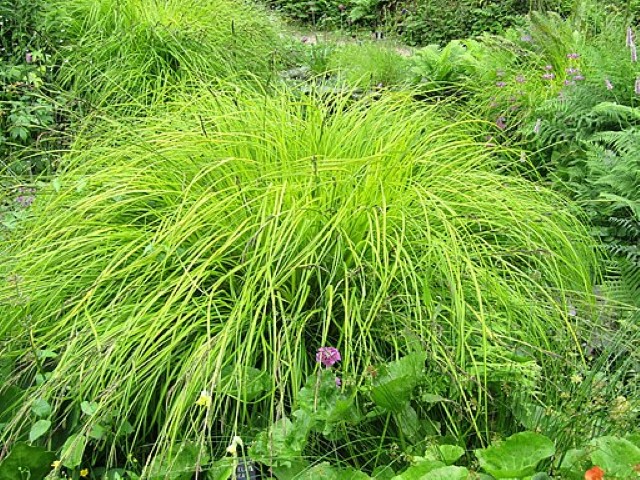



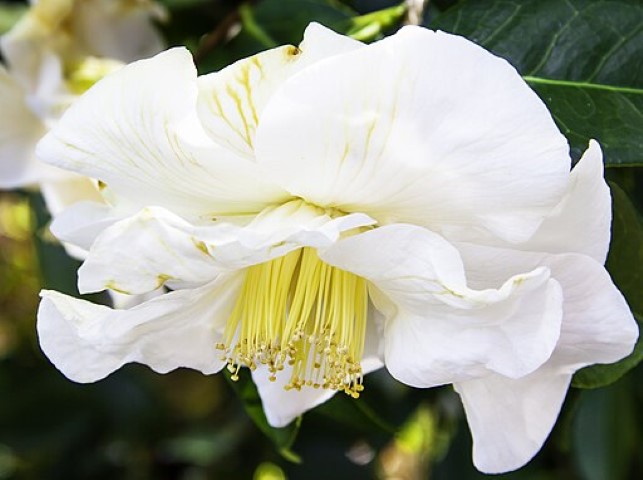
and from Sarah’s garden…



Carol had some winter jasmine…
… and there are early daffodils coming out at Veryan’s…
Jobs for the week.
As we were low on numbers and some of the listed jobs were not possible to do without our absent leader’s advice, we pitched in where we could.
Emptying and spreading compost
The compost was overdue for a good sort out. One of the sections needed emptying and today was the day!

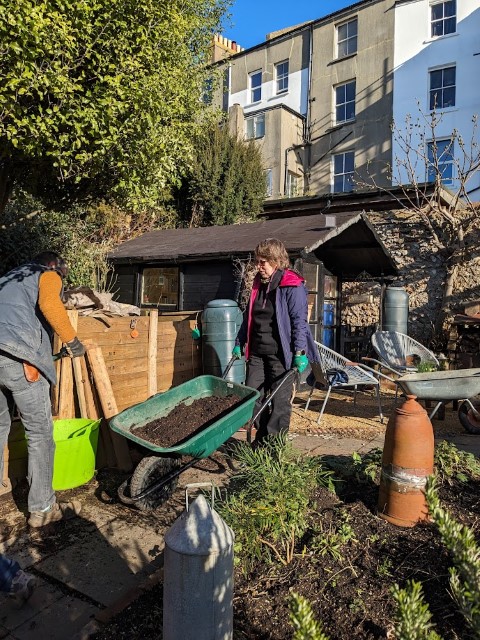
The compost was to be spread around on the winter beds to improve the soil and act as a mulch. There was some grumbling about the contents…bits of crock, twigs and branches that were way too big, plastic labels and sellotape. These should not be going into the compost bins and we considered ourselves well and truly ticked off…

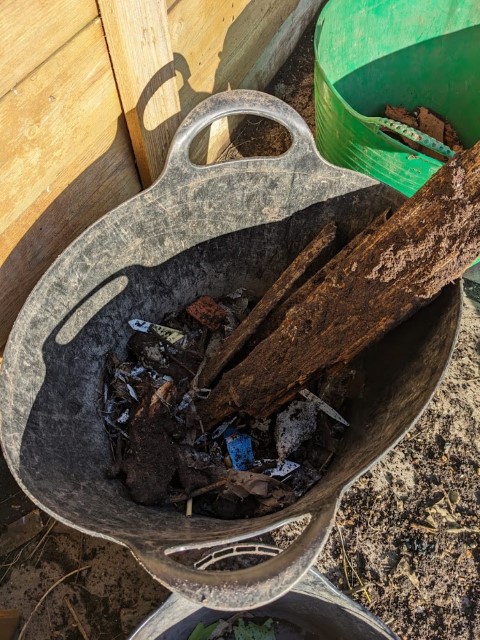
I see what they mean!
Sorting the leaf-litter
Some time ago a dedicated, open composter was set up just for leaves. Leaves take quite some time to compost down but eventually produce fantastic, crumbly, fine compost which can be added to others for extra nutrients or as a seed compost. The only trouble is that the good stuff is at the bottom…



Take the top layers off keeping them on a large tarpaulin, locate the decent stuff and bag it up, then put the un-rotted leaves back in…phew!
Sow seeds
Although it is still January, it is a good time to get some plants going from seed. Today there were sweet peas, Eschscholzia californica and others to get started.



Root trainers come in hand for sweet peas as they provide space for the long tap-roots to develop and help prevent root disturbance when potting the plant on.

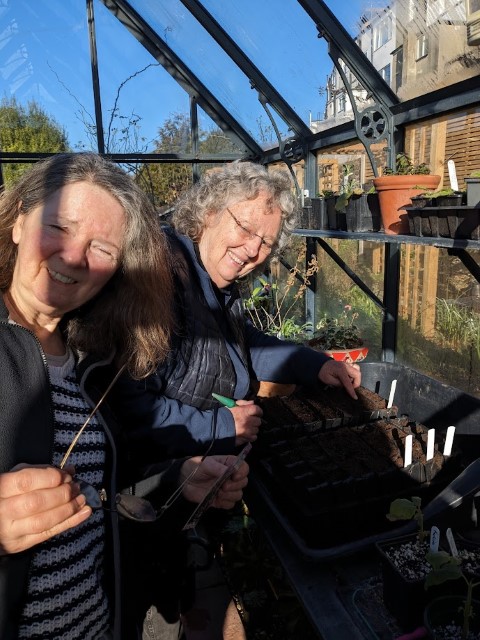

Tend to the house plants
The succulents in the conservatory were due for a tidy-up and watering…


…and there were other plants to be tidied too…



Then it was time for a break, some cake and a wind-down, all helped by a very friendly pooch!


No cake for you Ronnie!
See you next time.
